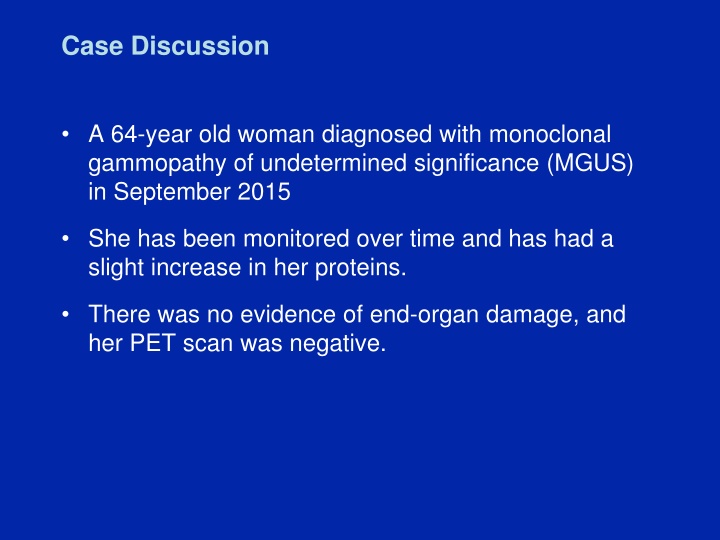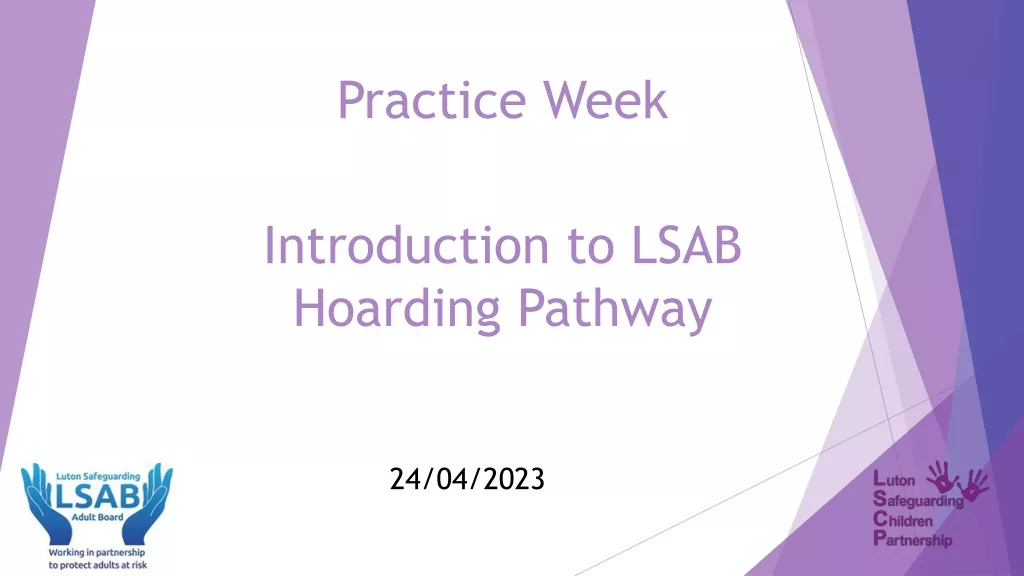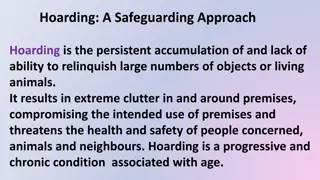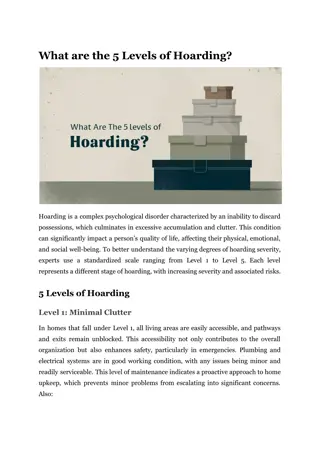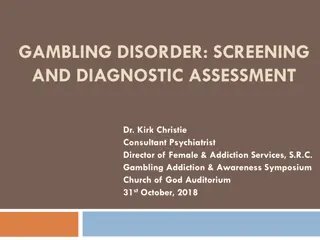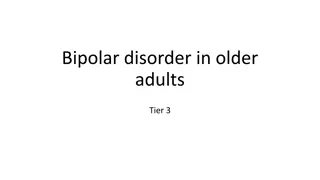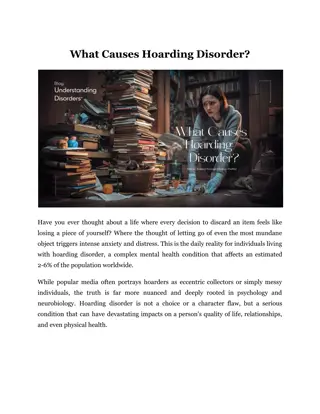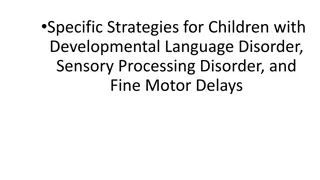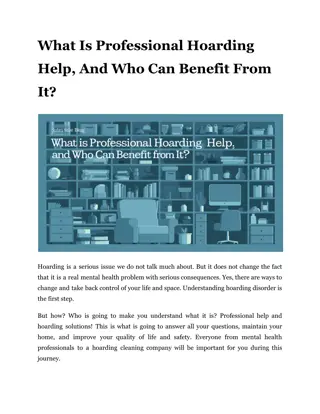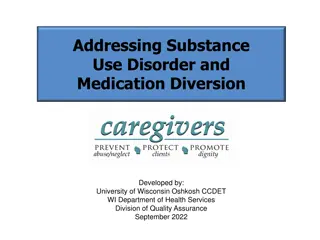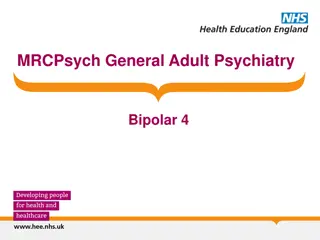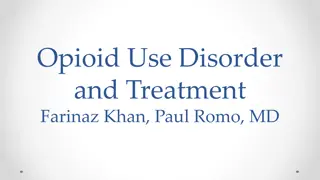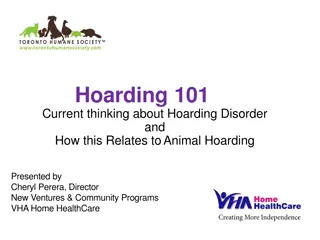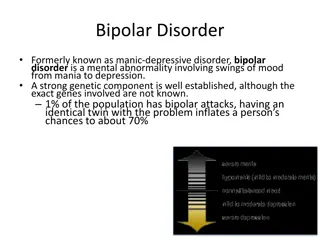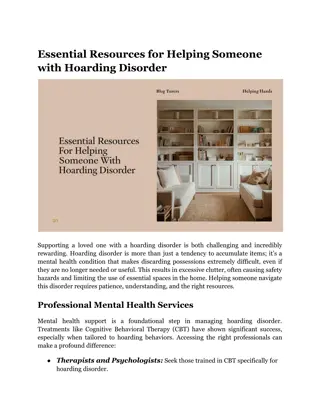Hoarding Disorder and its Impact
Hoarding disorder is characterized by persistent difficulty discarding possessions, leading to clutter and distress. It can be linked to various mental health conditions, physical illnesses, and cognitive challenges, affecting individuals in different ways. Understanding the diagnostic criteria and underlying factors is essential to provide effective support and intervention for those struggling with hoarding tendencies.
Download Presentation

Please find below an Image/Link to download the presentation.
The content on the website is provided AS IS for your information and personal use only. It may not be sold, licensed, or shared on other websites without obtaining consent from the author.If you encounter any issues during the download, it is possible that the publisher has removed the file from their server.
You are allowed to download the files provided on this website for personal or commercial use, subject to the condition that they are used lawfully. All files are the property of their respective owners.
The content on the website is provided AS IS for your information and personal use only. It may not be sold, licensed, or shared on other websites without obtaining consent from the author.
E N D
Presentation Transcript
Case Discussion A 64-year old woman diagnosed with monoclonal gammopathy of undetermined significance (MGUS) in September 2015 She has been monitored over time and has had a slight increase in her proteins. There was no evidence of end-organ damage, and her PET scan was negative.
Indications for Considering Treatment (IMWG Consensus Guidelines) At least 1 of the CRAB Criteria (evidence of end-organ damage) CRAB criteria Hypercalcemia Serum calcium >2.75 mmol/L (>11 mg/dL) Serum creatinine >2 mg/dL or creatinine clearance <40 mL per min Hb >2.0 g/dL below the lower limit of normal or a hemoglobin value <10.0 g/dL 1 osteolytic lesions on skeletal radiography, CT or PET-CT Renal failure Anemia Bone New myeloma defining events: The biomarkers 60% clonal bone marrow plasma cells Serum involved/uninvolved free light chain ratio 100 >1 focal bone lesion on MRI Rajkumar SV et al. ASCO 2016 Education Session.
QuiRedex Trial of Len/Dex in High-Risk SMM Phase III study of len/dex vs observation for pts with high- risk smoldering MM Len/dex (n = 57) Observation (n = 62) HR, p-value Efficacy Median time to progression Not reached 23 mo 0.24, <0.0001 Median OS Not reached Not reached 0.43, 0.024 Mateos MV et al. Lancet Oncol 2016;17:1127-36.
Phase II Trial of Elo/Len/Dex in High-Risk Smoldering MM PFS Subsequent to this interview, these data were presented at ASH 2016 With permission from Ghobrial IM et al. Proc ASH 2016;Abstract 976. PR = 19/23 (82.6%); CR + VGPR + PR + MR = 23/23 (100%)
Case Discussion An 87-year-old man initially diagnosed with smoldering myeloma 2 years earlier Presents with lytic bone disease and anemia and is considered to have symptomatic multiple myeloma
Case Discussion An 87-year-old man is initially diagnosed with smoldering myeloma Presents 2 years later with lytic bone disease and anemia and is then considered to have symptomatic multiple myeloma He receives RVd-lite lenalidomide maintenance and is currently in a CR
TOURMALINE MM2: A Phase III Trial of Ixazomib/Len/Dex vs Len/Dex for Newly Diagnosed MM NCT01850524 Ixazomib + lenalidomide + dexamethasone Enrollment (n = 701) Newly diagnosed MM Not eligible for stem cell transplant R Placebo + lenalidomide + dexamethasone Primary endpoint: PFS www.clinicaltrials.gov. Accessed June 2017
TOURMALINE-MM1: Oral Ixazomib with Len/Dex for MM Phase III trial of pts with relapsed/refractory MM treated with ixazomib and lenalidomide/dex (ixazomib group) or placebo and lenalidomide/dex (placebo group) Ixazomib group (n = 360) Placebo group (n = 362) HR, p-value Efficacy Median PFS 20.6 mo 14.7 mo 0.74, 0.01 ORR 78% 72% , 0.04 Median overall survival: not reached in either group Moreau P et al. N Engl J Med 2016;374(17):1621-34.
SWOG S0777: VRd versus Rd for Newly Diagnosed MM Phase III study of VRd versus Rd for pts with newly diagnosed MM without intent for immediate ASCT HR, p-value Outcome VRd Rd Median PFS (n = 242, 229) 43 mo 30 mo 0.712, 0.0018 Median OS (n = 242, 229) 75 mo 64 mo 0.709, 0.025 ORR (n = 216, 214) 81.5% 71.5% Durie B et al. Lancet 2017;389:519-27.
IFM 2009 Trial: RVD with Transplant versus RVD Alone for Newly Diagnosed MM Phase III study of patients with transplant-eligible, newly diagnosed MM Treatment: RVD with transplant versus RVD alone followed by len maintenance (1 y) Transplant (n = 350) RVD (n = 350) HR, p-value Outcome Median PFS 50 mo 36 mo 0.65, <0.001 Overall survival (4 y) 81% 82% 1.16, 0.87 Response Complete response Partial response 59% 11% 48% 20% , 0.03 Attal M et al. N Engl J Med 2017;376(14):1311-20.
Predictive Value of Minimal Residual Disease (MRD) in the IFM 2009 Trial Bone marrow MRD evaluation (pre- and postmaintenance) in patients with VGPR Prediction of PFS by MRD status as determined by NGS PFS (3 y) in pts achieving CR MRD-negative (<10-6) MRD-positive ( 10-6) (Patients in CR) Premaintenance 87% 63% Postmaintenance 92% 64% Avet-Loiseau H et al. Proc ASH 2015;Abstract 191.
DETERMINATION: A Phase III Trial of RVD with or without ASCT for Newly Diagnosed MM NCT01208662 RVD Estimated enrollment (n = 660) Newly diagnosed MM 65 y R RVD + ASCT Patients in both arms will receive lenalidomide maintenance until disease progression Primary endpoint: PFS www.clinicaltrials.gov. Accessed June 2017
Case Discussion A 76-year-old man diagnosed with multiple myeloma in 2006 Progressed through multiple lines of therapy including lenalidomide/dexamethasone (dex) and ixazomib/lenalidomide/dex Received daratumumab plus pomalidomide/dex in June 2016 and is faring well
Management of Daratumumab-Associated Infusion-Related Reactions For a busy oncology practice in the community, I always say there s two things that people are doing. One is: They re splitting doses. But probably the most important one is: Just give as much as you can on Day 1, and you re going to flush some of that reaction. So by the time you get to the second week and it s true with most of the monoclonals then you tend not to have reactions. So it s just Day 1 that needs to be managed. Dr Rafael Fonseca
POLLUX: A Phase III Trial of Daratumumab/Len/ Dex for Relapsed/Refractory MM Patients with MM (n = 569) who had received 1 or more prior therapies received daratumumab and len/dex (DRd) or len/dex (Rd) DRd (n = 286) Rd HR, p-value Efficacy (n = 283) Median PFS PFS (12 mo) Not reached 83.2% 18.4 mo 60.1% 0.37, <0.001 Overall response rate 92.9% 76.4% , <0.001 Most common Grade 3/4 adverse events: neutropenia, thrombocytopenia, anemia Daratumumab-associated infusion-related reactions reported in 47.7% of patients, mostly Grade 1/2 Dimopoulos MA et al. N Engl J Med 2016;375(14):1319-31.
Phase III CASTOR Trial of Daratumumab and Bortezomib/Dex for Relapsed/Refractory MM Patients with relapsed/refractory MM (n = 498) received bortezomib/dex (Rd) alone or in combination with daratumumab (DVd) DVd Vd HR, p-value Efficacy (n = 251) (n = 247) Median PFS PFS (12 mo) Not reached 60.7% 7.2 mo 26.9% 0.39, <0.001 Overall response rate 82.9% 63.2% , <0.001 Most common Grade 3/4 adverse events: neutropenia, thrombocytopenia, anemia Daratumumab-associated IRRs: 47.7% of patients, mostly Grade 1/2 Palumbo A et al. N Engl J Med 2016;375:754-66.
Case Discussion A 45-year-old man who was diagnosed 4 years ago with MM Received RVD with transplant followed by len maintenance for 18 mo Progressed with bone disease and received radiation therapy and carfilzomib/pomalidomide/dex and achieved a VGPR
Case Discussion A 45-year-old man who was diagnosed 4 years ago with MM Received RVD with transplant followed by len maintenance for 18 mo Progressed with bone disease and received radiation therapy and carfilzomib/pomalidomide/dex and achieved a VGPR Experienced relapse again, received daratumumab/len/ dex and has achieved a PR
POLLUX and CASTOR Trials of Daratumumab for Relapsed/Refractory MM POLLUX DRd (n = 286) Rd HR, p-value Efficacy (n = 283) Median PFS Not reached 18.4 mo 0.37, <0.001 Overall response rate 92.9% 76.4% , <0.001 CASTOR DVd Vd HR, p-value Efficacy (n = 251) (n = 247) Median PFS Not reached 7.2 mo 0.39, <0.001 Overall response rate 82.9% 63.2% , <0.001 Dimopoulos MA et al. N Engl J Med 2016;375(14):1319-31. Palumbo A et al. N Engl J Med 2016;375:754-66.
PAVO: A Phase Ib Study of Subcutaneous Daratumumab (DARA) for Relapsed/Refractory MM Patients with relapsed/refractory MM (n = 41) received 1,200 mg and 1,800 mg subcutaneous DARA in combination with human hyaluronidase enzyme (rHuPH20) to facilitate absorption. Preliminary data suggest that subcutaneous DARA-PH20 may enable similar response rates to IV DARA monotherapy. At the 1,800-mg dose of DARA-PH20, overall response rate: 41% Infusion-related reactions (IRRs) were reported in 9/41 pts (22%) and were mostly Grade 1/2. All IRRs developed 6 h of the first SC infusion and were controlled with antihistamines, corticosteroids, antiemetics or a bronchodilator. Subsequent to this interview, these data were presented at ASH 2016 Usmani SZ et al. Proc ASH 2016;Abstract 1149.
Venetoclax (VEN) for Relapsed/Refractory MM Phase I study of VEN monotherapy for pts with relapsed/refractory MM Efficacy All pts (n = 66) t(11;14) No t(11;14) Overall response rate VGPR 21% 15% 40% 27% 6% 6% Median time to progression 2.6 mo 6.6 mo 1.9 mo Grade 3/4 hematologic AEs: thrombocytopenia (32%), neutropenia (27%), anemia (23%), leukopenia (23%) No TLS events reported Kumar S et al. Proc IMW 2017;Abstract 129.
Venetoclax with Bortezomib/Dex for Relapsed/Refractory MM Phase Ib study of pts with relapsed/refractory MM treated with venetoclax/bortezomib/dex All pts (n = 65) BTZ nonrefractory (n = 44) BTZ refractory (n = 21) Response Overall response rate 68% 89% 24% Stringent CR 5% 7% 0% CR 12% 18% 0% VGPR 23% 32% 5% PR 28% 32% 19% Moreau P et al. Proc ASH 2016;Abstract 975.
Phase II Study of Pembrolizumab/Pomalidomide/ Dex for Relapsed/Refractory MM ITT Double refractory (n = 32) High risk (n = 27) Response (n = 48) ORR 60% 66% 56% sCR/CR 8% 4% 11% VGPR 19% 18% 4% PR 33% 44% 41% Median follow-up = 15.6 mo Median duration of response = 14.7 mo Badros AZ et al. Proc ASH 2016;Abstract 490; Badros A et al. Blood 2017;[Epub ahead of print].
KEYNOTE-023: Pembrolizumab/Lenalidomide/ Dex for Relapsed/Refractory MM Phase I study of pembrolizumab with lenalidomide/dex N = 34 patients with R/R MM after disease progression on 2 prior therapies Objective response rate: All evaluable patients: 13/17 (76%) Lenalidomide-refractory disease: 5/9 (56%) Few low-grade immune-related adverse events San Miguel et al. Proc ASH 2015;Abstract 505.
Response to CAR-BCMA T-Cell Therapy and Adverse Events Pts with advanced relapsed/refractory MM enrolled: n = 12 Method: Single infusion of anti-BCMA CAR T cells after a 3-day regimen of cyclophosphamide/fludarabine CAR-BCMA T cells eliminated plasma cells without direct organ damage. Significant antimyeloma responses were associated with the highest levels of CAR-BCMA T cells in the blood. Toxicites consistent with cytokine release syndrome (including fever, hypotension and dyspnea) were substantial but reversible. Ali SA et al. Blood 2016;128(13):1688-700. Proc ASH 2015;Abstract LBA-1.
